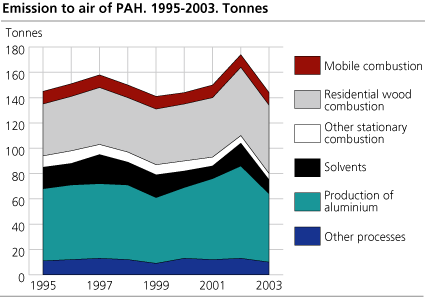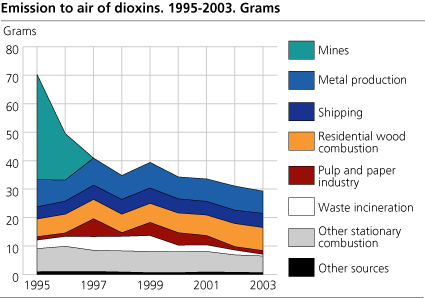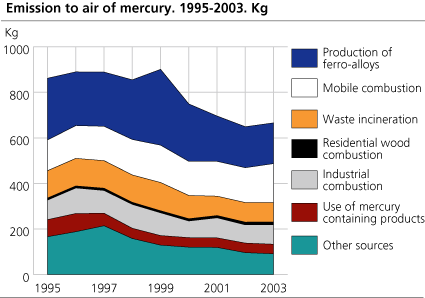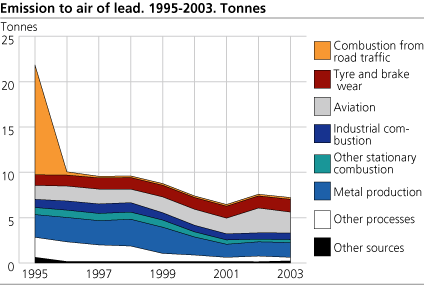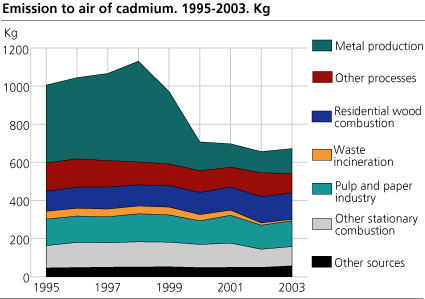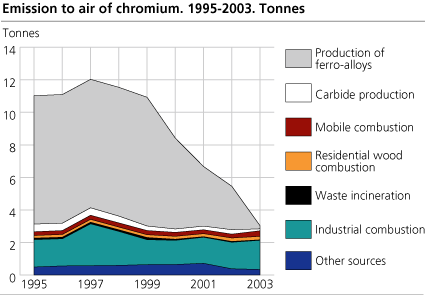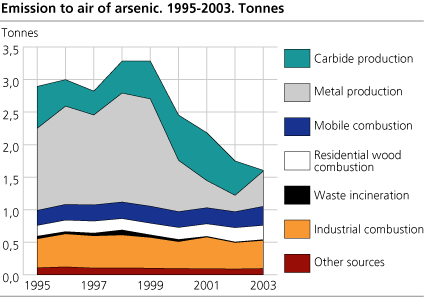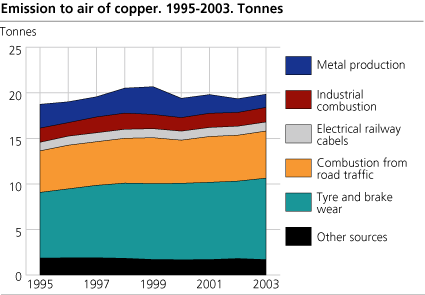Content
Published:
This is an archived release.
Industrial emissions down
Industrial emissions of heavy metals to air have been substantially reduced since 1995, mainly due to improved treatment systems as required by the authorities and reduced industrial activity in some sectors. Compared with 2002, emissions in 2003 have been reduced for the persistent organic pollutants PAH and dioxins and for the heavy metals chromium and arsenic. Emissions of other heavy metals have remained at about the same levels as in 2002.
The figures presented here have been calculated by Statistics Norway (SSB) in collaboration with the Norwegian Pollution Control Authority (SFT).
Policy objectives for reducing emissions
Though the Convention on Long-Range Transboundary Air Pollution, Norway is internationally committed to reduce emissions of PAH, dioxins, lead, cadmium and mercury below 1990 emission levels.
At the national level, the authorities have set targets for reducing the total emissions of selected environmental hazardous substances by 2010, using 1995 as a reference year. The figures presented in this article only refer to emissions to air.
Reduced industrial emissions
Emissions of heavy metals from the manufacturing industry have been significantly reduced since 1995, up to 80 per cent for chromium. The reduction of heavy metal emissions are primarily due to improved treatment systems and manufacturing processes and the closing down of a number of industrial establishments. Residential wood combustion has now taken over as the most important source for air emissions of PAH, dioxins and cadmium. Since1995 there has been an increase in emissions of copper, chromium, arsenic, cadmium and mercury from road traffic, largely due to higher emissions from diesel powered cars. Emissions of lead on the contrary, went dramatically down in the period 1990 to 1997, due to restrictions on leaded petrol, but have increased slightly since.
Electricity prices resulted in increased emissions from combustion
Higher electricity prices in the beginning of 2003 contributed to a significant increase in the consumption of heating and heavy fuel oil, both by domestic and industrial users. This resulted in increased emissions of chromium, cadmium, mercury and arsenic from combustion during 2003 compared with 2002.
Emissions in 2003
Nearly 144 tonnes of Polycyclic Aromatic Hydrocarbons (PAH) were released to the atmosphere during 2003, mainly from manufacturing of aluminium and domestic use of firewood. This is 17 per cent lower than the previous year. The decrease is explained primarily by the modernization of two aluminium plants and by particularly high emissions in 2002 caused by an accident in one aluminium plant.
Emissions of dioxins came to about 29 grams in 2003, a slight decrease from 2002 due in part to improved treatment processes in one major waste incineration plant. Domestic use of firewood accounted for one fourth of the dioxins emitted during 2003 and was the main source. The second main source was from metal manufacturing.
Approximately 660 kilos of mercury were emitted to air during 2003, a slight increase from 2002. The increase was mainly caused by higher emissions from coastal traffic as more fuel was purchased. A new emission factor has been used in the calculations for burning of firewood, resulting in a reduced relative importance of this source compared with previous calculations.
Leaded petrol is still used in small aircrafts, and this was the main source for the more than 7 tonnes of lead emitted during 2003. Reduced purchases of this type of fuel are largely responsible for the 5 per cent reduction of lead emissions compared with 2002. Tyre and brake wear contributed to almost 20 per cent of the lead emissions to air in 2003. These sources are included in these calculations for the first time, and therefore the total level of lead emitted is higher than in previous publications.
Emissions of cadmium to air have remained more or less unchanged at about 700 kilos the last four years. The main sources of cadmium are domestic use of firewood, metal manufacturing and the pulp and paper industry.
Only about half of the amount of chromium emitted in 2002 was emitted in 2003. This was mainly because of closed manufacturing plants. The amount released during 2003 came to about 3 tonnes.
More than 1.6 tonnes of arsenic were emitted in 2003 - slightly less than the previous year. The closing down of a manufacturing plant resulted in 500 kilos less arsenic emitted from carbide production, but this was counteracted by increased emissions from metal production due to the higher arsenic content of the raw materials.
Emissions of copper came to nearly 20 tonnes in 2003, roughly the same amount as in 2002. Almost half of the copper emitted to air came from tyre and brake wear, and one fourth came from combustion of petrol and diesel.
Uncertainties
The emission data are calculated by Statistics Norway in cooperation with the Norwegian Pollution Control Authority. They are based on measurements from large industrial plants and combustion plants, combined with calculations based on activity data and emission factors. There is large uncertainty associated with the statistics for heavy metals and persistent organic pollutants due to variations in reported emission data and because the emission factors used are not necessarily calibrated for conditions in Norway.
New emission figures
Other emission figures are also being published: Emissions to air of greenhouse gases and Emissions to air of persistent organic pollutants and heavy metals .
Read more about emissions to air:
NOS Emissions to air 1973-2003
State of the environment Norway
Tables in the StatBank
Tables:
The statistics is published with Emissions to air.
Contact
-
Statistics Norway's Information Centre
E-mail: informasjon@ssb.no
tel.: (+47) 21 09 46 42

